

GD — Society for Dermopharmacy
 |
Issue 4 (2001) |
Dermocosmetics
GD-Symposium in Düsseldorf on 17 October 2001
Effects of Dermocosmetics
After their 5th Annual
Meeting in Zurich, the Gesellschaft für Dermopharmazie organized
for the first time a further event of supraregional significance in the
year 2001: "Effects of Dermocosmetics" was the title of a symposium
which took place with the support of the industry group Schwarzkopf &
Henkel at the Fritz-Henkel-House in Düsseldorf on 17 October. The
lecture topics were of interdisciplinary interest and thus approximately
120 dermatologists, pharmacists as well as representatives from academia,
authorities, the specialist press, consumer associations, contract research
institutes as well as from the pharmaceutical and cosmetical industry
met to obtain and exchange current information as to latest developments
in the field of dermocosmetics. Scientific meeting heads were professor
Dr. Rolf Daniels, Brunswick, Dr. Thomas Förster, Düsseldorf,
and professor Dr. med. Hans Christian Korting, Munich, a pharmaceutical
technologist, a cosmetic scientist and a dermatologist.
In his opening address
Dr. Joachim Kresken, pharmacist and president of the Gesellschaft für
Dermopharmazie (Society for Dermopharmacy) gave an overview about the
priorities of the event as well as of the structure and tasks of the GD.
Since its foundation in the year 1995, the society was very successful
in its function as intermediate between science, industry and practice.
Quality assurance, consumer protection, public relations as well as the
promotion of the cooperation of dermatologists, pharmacists and other
experts active in the field of dermopharmacy are essential pillars in
this context. Among the meanwhile 270 ordinary members - mainly from the
areas medicine, pharmacy and cosmetics - nearly all experts of the German-speaking
area are represented, dealing with questions concerning medicinal skin
preparations and interested in an interdisciplinary exchange of thoughts
respectively corresponding cooperations. Furthermore, there are more than
30 companies of the pharmaceutical and cosmetic industry supporting the
GD's activities as sponsoring members.
GD Activities in the pre-politicial
Field
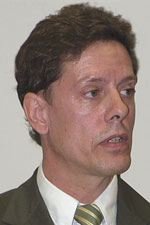 Dr. Joachim Kresken |
As Kresken explained, the GD makes efforts in a pre-political area in many respects as to safeguard the interests in the area dermatics and cosmetics. Thus it takes care on a permanent basis to establish and maintain useful contacts with federal and EC authorities relevant in this field. Further activities are the organization of consensus conferences, the establishing of guidelines as well as the publication of scientific statements. All position papers published by the GD can be looked up in the Internet at the GD-Homepage (www.gd-online.de) and in the archived online-issues of DermoTopics (www.dermotopics.de). The statements refer to cosmetics in view of the term 'emulsifier-free', concerning the topic of issueing of medical prescriptions for purposes of esthetical medicine, regarding the potential of a penetration enhancement by polyethylenglycol (PEG)-compounds in cosmetics, the potential of occlusion by liquid paraffin in cosmetics as well as requirements to dermocosmetics. The last-mentioned three statements are included in this issue of DermoTopics.
The guidelines published by the GD so far refer to dermocosmetics for the cleansing and care of dry skin. They address experts, producing, testing, marketing or giving advice concerning cosmetics for person with dry skin. On the basis of these guidelines an advisory brochure for consumers has been established which had been presented to the public on the occasion of the symposium. This publication informs how dry skin should be adequately cleaned and cared for. At present the GD department Dermocosmetics is elaborating guidelines regarding dermocosmetic sun protection.
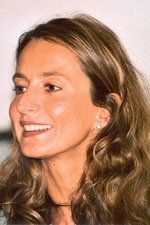 Professor Dr. med. Martina Kerscher |
In the Focus of Interest - Skin-ageing
Skin represents the organ which reflects the human ageing process in the most distinct way. As the 'fountain of youth' proves, everlasting beauty, attractivity and youth have always been a dream of mankind. Besides nowadays, people get on average much older than still 100 years ago, when the age group from 60 to 80 years was much smaller. Therefore, the focus of the consumer interest is directed on measures for the retarding of skin ageing, as professor Dr. med. Martina Kerscher, University Hamburg explained in her basic lecture about new trends in dermocosmetics.
In her view, light protection preparations for the avoiding of UV-affections as well as humectant agents protecting from dehydration play an important role for the retarding of skin ageing. Since according to latest insights free radicals are intensifying ageing processes in skin, the use of antioxidants in anti-age products is to be taken in consideration. At a sufficient concentration and stability, L- ascorbic acid (vitamin C), a-tocopherol (vitamin E), Coencyme Q 10 and melatonin can have a photoprotective effect. The same applies to polyphenolic epicatechines contained in extracts of green tea which are meanwhile included in many cosmetic products as natural antioxidants. Pursuant to studies, topically applied, vitamin-A-acid (retine acid) induces a collagen regeneration and improves moreover also other age-related skin changes.
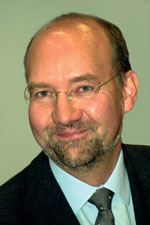 Professor Dr. med. Jean Krutmann |
Summarizing, the lecturer emphasized, there is a multitude of novel dermocosmetics with very different active substances for the retarding of skin ageing. It belongs to the responsibilities of scientific dermocosmetics to establish guidelines for the testing of the effectiveness and safety of these substances.
UV-impairments partly repairable
Light- or photoageing describes the accelerated and premature ageing process of skin caused by the more short-wave UVB-radiation (290-320 nm) and as well by the more long-wave UVA-radiation (320-400 nm). As professor Dr. med. Jean Krutmann, Hautklinik der Heinrich-Heine-Universität Düsseldorf (Dermatological Clinic at the Heinrich-Heine-University) expounded, UVB produces specifical DNA-affections entailing light ageing. A partial repair of such impairments is in general possible by topical application of DNA-repair enzymes packed in liposomes. According to latest analyses, the UVB-induced expression of the matrix metal proteinase-1 in cultivated dermal fibroblasts can be avoided playing a key role in triggering of clinical symptoms of photoageing.
In view of the light ageing as a result of UVA-radiation an impairment of the mitochondrial DNA in dermal fibroblasts is of crucial significance. Mutations thus caused remain over years. Furthermore, their content in skin further increases after a single induction by repetitive UVA-radiation also without renewed UVA-exposition. The DNA-impairments are attributed to oxidative stress. In order to avoid the progression of light ageing and if possible foster regenerative processes it is obvious to apply topical and possibly also systemical antioxidants not only for the time of sun exposition but also in the radiation-free interval.
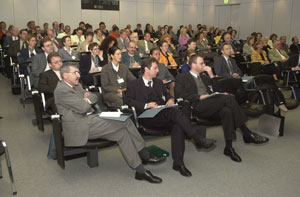 Approximately 120 skin experts of different professions met for an interdisciplinary exchange of thoughts about dermocosmetics on the occasion of the GD-symposium in Düsseldorf. The lecture hall of the Fritz-Henkel-Haus was filled to the last seat. |
Topic complex Alopecial
Alopecia may have a series of differing causes which are to be systematically influenced, emphasized Professor Dr. med. Ralf Paus, Hautklinik am Universitätsklinikum Hamburg-Eppendorf (Dermatological Clinic at the University Clinical Center). The most frequent hair growth disorders occurring in the practice are due to hair cycle failures. This is why special attention by research is directed on the development of so-called hair-cycle modulators for an effective and a smallest possible influence of the katagenic phase as to side effects.
As the latter represents an apoptosis-driven organ involution process, the manipulation of the apoptosis of hair folicle keratinocytes is here of particular interest. Studies at the mouse model have shown that glucocorticoids and immuno philinligands are very potent katagenic manipulators. Therefore, they offer a possible dermopharmaceutic treatment approach against alopecia. Further important information provide studies regarding the significance of certain growth factors in the katagenic regulation.
The development of stemcell-protective substances is equally of special clinical significance- above all with alopecia caused by chemo- or radiation treatment and with scarring alopecias - as well as with pharmaca for the recovery of the hair follicle immune system after its collapse (with alopecia areata). New preparations should ideally be topically applicable and preferably or even exclusively be effective on the hair follicle.
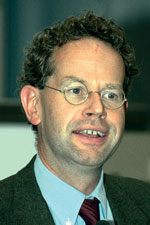 Professor Dr. med. Ralf Paus |
Hair Condition Improvement
Besides alopecia, frequently also dullness, split hair ends and hair break cause problems. As Dr. Elisabeth Poppe of the company Schwarzkopf, Hamburg explained, hair conditioners help in this case for instance as protection from damages resulting from combing, hair drying, sunlight, permanent preparations and hair dyes or conceal the damages caused by these influences.
For the outer appearance and tactile hair properties mainly its surface, the cuticula is responsible. If the latter is damaged sticking out or lacking scales as well as an excess of negative charges appear. The quaternary ammonia compounds, contained in hair conditioning agents, neutralize the negative charge surplus and hydrophobize the hair surface which has become more hydrophile by the damaging processes.
The mechanical hair properties, for example the resistance to tearing are determined by the cortex. Its impairment mainly comes about by a change of the protein structure. So-called structurands as panthenol are able to penetrate the cortex and to reinforce its structure. An optimal effect develops a conditioning agent if the basic formulation is optimally adapted to the active substances. An effectiveness proof is effected by biophysical measurements as well as half-side comparisons at testees.
 Dr. Elisabeth Poppe |
Animal-experiment free test Methods
While in Germany the current animal protective law stipulates to perform safety-toxicological tolerance tests of cosmetics without animal experiments, a pass of the corresponding amendment of the EC cosmetics guidelines did not succeed so far due to formal reasons. Professor Dr. med. Horst Spielmann of the Bundesinstitut für gesundheitlichen Verbraucherschutz und Veterinärmedizin (BgVV) (Federal Institute for Sanitary Consumer Protection and Veterinary Medicine) in Berlin pointed out that the scientists involved in industry and authorities have already reached a consensus some years ago that cosmetic finished products in the EC member states are only subject to animal experiment-free test methods. These methods are meanwhile also applied in the US and Japan. Also for the testing of new chemical substances animal experiments are in part no longer necessary (also refer to the news 'New methods of animal-experiment-free cosmetics testing' and 'OECD recommends cell tests for the examination of tnew drugs, chemicals and cosmetic ingredients')
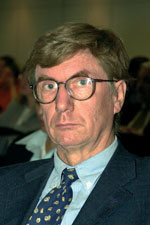 Professor Dr. med. Horst Spielmann |
Dr. Dirk Petersohn of the company Henkel, Düsseldorf, reported about
the establishing and application of modern molecular biological techniques
for the analysis of skin ageing processes on molecular level. The sunlight
with its part of UV-rays plays an important role in photoageing.
To date only few corresponding marking proteins of the skin have been
described. The mentioned techniques allow, in combination with the full
skin model developed at Henkel, a description of ageing processes caused
by sunlight and to determine the effects of bio-active substances or complex
cosmetic formulations at the skin.
Experience of the
Analyst indispensable
Dr. Betsy Hughes-Formella of the institute BioSkin in Hamburg deals with test strategies for substances against dry skin. For studies special importance is to be attached on defining exactly the target group and to chose the correct objective variables. Important is the formation of a possibly homogeneous group of suitable testees with clearly defined participation and exclusion criteria. Regarding the objective variables not only measurable improvements of the skin condition are to be considered but also those which are 'experiencable' by the applicant.
Objective and subjective clinical symptoms are the basis for the assessment of a preparation as well as a series of non-invasive bio-engineering methods by means of which the electrical properties of skin, the barrier function, the mechanical properties, the desquamation and the topography of the skin surface can be assessed. An important role for the study design also plays the selection of the skin areas to be tested, the type and frequency of the substance application as well as the consideration of exterior influences. A satisfactory and standardized test strategy, however, always only represents the correct instrument but is not in a position to replace the experienced examinor.
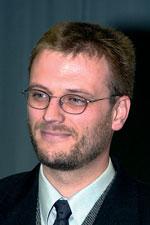 Dr. Dirk Petersohn |
Evaluation of Biosensorics
Dr. Thomas Gassenmeier of Henkel, Düsseldorf. lectured about practice
and rational of biosensorics of cosmetic products. The term biosensorics
refers to the scientifized assessment of sensoric properties of consumer
goods, raw materials and others by a trained expert panel. In general
everything can be assessed that is ascertainable by a sense organ. Physiological
and psychological factors influence the assessment. A decisive role plays
the mental interpretation which turns out interindividually different.
Therefore, controlled conditions and a formulation of question adapted
to the test design are of crucial importance.
The lecturer presented a test array concerning the sensoric assessment
of skin care products which has been validated in a ring study. It is
based on two fundamental principles, i.e. the use of exactly defined sensoric
parameter and the implementation as comparable test with reference products.
With this array it is possible to assess the influence of prescription-technical
modifications of cosmetic emulsions, pure emollients and products on surfactant
basis.
 Dr. Betsy Hughes-Formella |
Biophotonics offer new possiblities
Biophotonics offer new possiblities of a non-invasive and ultra-sensitive assessment of metabolic processes in skin as well as for the determination of corresponding protection effects, as has been presented by Dr. Andreas Schrader of the institute in Holzminden of the same name. By means of this method the photone-emission of the skin induced by UV-light, the ICL-S (Induced Chemiluminescence of Human Skin) can be measured. UV-radiation leads to an increased formation of reactive oxygen radicals which initiate additional oxidative processes and thus impair unaffected skin cells. These processes are in partial reactions chemiluminescent.
In Schrader's opinion the reduction of the ICL-S will be of importance in future especially for the development of new sun protection agents. As studies could show, ICL-S can be reduced by effective chemical UVA-filter by up to 60 percent, by antioxidants by 10 to 20 percent. The new procedure allows a direct in-vivo measurement. The realization of the tests is easy and fast, whereas the UV doses applied fall far below the minimal erythem threshold. A new instrument especially developed allows the measurement of the ICL-S directly after UV-radiation.
Cream Bases equally effective
When developing skin care products, the focus of interest is increasingly directed on cream bases. As Dr. Armin Wadle of Henkel reported, they are not considered as being an active substance carrier, but represent more and more an independent active principle. By means of qualified emulsifying agents, multifunctional cream bases are formulated which have a high cosmetical acceptance, good tolerance and furthermore improve the skin condition.
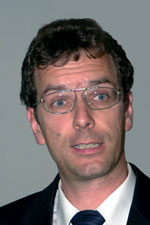 Dr. Thomas Gassenmeier |
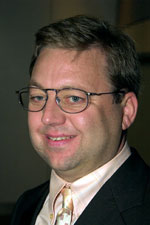 Dr. Andreas Schrader |
Multifunctionally effective are for instance the lipoproteins, produced from the seeds of different plants. They exert emulsifying as well as emulsion stabilizing effects on oil-in-water emulsions thus making conventional emulsifiers superfluous. Moreover, the lipoproteins have an active effect on the skin enhancing their smoothness and elasticity.
An improvement of the skin condition could also be proven for lamellar creams, for instance on the basis of sugar emulsifiers. These formulations could have a similar structure as the intercellular lipids in the stratum corneum. Thereby they could contribute to their restructuration and ameliorate the barrier properties of the skin. At the same time a comprehensible increase of skin humidity and skin smoothness comes about.
Potential of new Gel Systems
Professor Dr. Rolf Daniels of the Institut für Pharmazeutische Technologie der Technischen Unviversität Brunswick (Pharmaceutical Technology of the Technical University) informed about new gel systems in the dermocosmetic application. For some years already aqueous-alcoholic polymer gels (with or without dispersely prepared lipid phase) are used as a standard.
New opportunities offers the gel former hypromellosis. It allows the production of hydrodispersion gels in the submicron area to which both alcohol and electrolytes can be added. Furthermore, such formulations could be sterilized in the final receptacle.
Special interest is directed on surfactant gels, for example on basis of lamellar and cubic mesophases. Increasing insights about the reaction of such systems allow the production of gels with various properties, the interaction with the skin of which can be used in applications. Moreover, they contribute to the releasing of active ingredients.
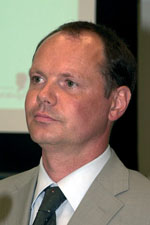 Dr. Armin Wadle |
Anti-age Effect proven
Dr. Thomas Förster of the company Henkel defines the emphasizing of the youthful appearance at increasing life expectancy as essential trend of our times. Correspondingly, there is an increasing demand for so-called anti-age products. As skin ageing concerns not only the dermis but also the basal membrane as well as the epidermis, such preparations have to have a broad effect on all relevant skin layers in order to be effective.
In an artificially cultured full-skin model, the team of Förster succeeded in identifying several anti-age active ingredients with different targets. The brands developed pursuant to this have proven effective in application studies. Both the quantitative measurement of the wrinkle depth repartition and the subjective assessment have shown that a younger appearance can be realized with these anti-age creams.
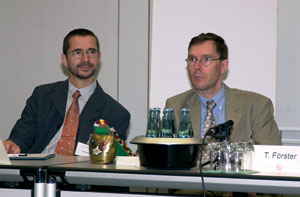 Professor Dr. Rolf Daniels (left), Institut für Pharmazeutische Technologie der Technischen Universität Brunswick (Institute for Pharmaceutical Technology of the Technical University) and Dr. Thomas Förster of the company Henkel, Düsseldorf, were acting as lecturers and as moderators. In cooperation with professor Dr. med. Hans Christian Korting, Dermatologische Klinik und Poliklinik der Ludwig-Maximilians-Universität München (Dermatological Clinic and Outpatient Clinic of the Ludwig-Maximilian-University) they were responsible for the scientific organization of the symposium. |
Whether or not the fountain of youth is in sight? The future and the 6th
Annual Meeting of the Gesellschaft für Dermopharmazie from 20 to
22 March 2002 in Hamburg will give further answers to this question.
top